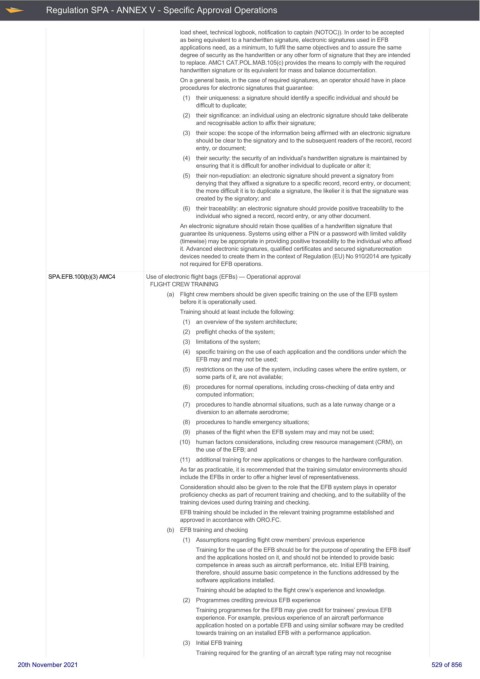Page 529 - UK Air Operations Regulations 201121
P. 529
~
~ Regulation SPA - ANNEX V - Specific Approval Operations Centrik
load sheet, technical logbook, notification to captain (NOTOC)). In order to be accepted
as being equivalent to a handwritten signature, electronic signatures used in EFB
applications need, as a minimum, to fulfil the same objectives and to assure the same
degree of security as the handwritten or any other form of signature that they are intended
to replace. AMC1 CAT.POL.MAB.105(c) provides the means to comply with the required
handwritten signature or its equivalent for mass and balance documentation.
On a general basis, in the case of required signatures, an operator should have in place
procedures for electronic signatures that guarantee:
(1) their uniqueness: a signature should identify a specific individual and should be
difficult to duplicate;
(2) their significance: an individual using an electronic signature should take deliberate
and recognisable action to affix their signature;
(3) their scope: the scope of the information being affirmed with an electronic signature
should be clear to the signatory and to the subsequent readers of the record, record
entry, or document;
(4) their security: the security of an individual’s handwritten signature is maintained by
ensuring that it is difficult for another individual to duplicate or alter it;
(5) their non-repudiation: an electronic signature should prevent a signatory from
denying that they affixed a signature to a specific record, record entry, or document;
the more difficult it is to duplicate a signature, the likelier it is that the signature was
created by the signatory; and
(6) their traceability: an electronic signature should provide positive traceability to the
individual who signed a record, record entry, or any other document.
An electronic signature should retain those qualities of a handwritten signature that
guarantee its uniqueness. Systems using either a PIN or a password with limited validity
(timewise) may be appropriate in providing positive traceability to the individual who affixed
it. Advanced electronic signatures, qualified certificates and secured signaturecreation
devices needed to create them in the context of Regulation (EU) No 910/2014 are typically
not required for EFB operations.
SPA.EFB.100(b)(3) AMC4 Use of electronic flight bags (EFBs) — Operational approval
FLIGHT CREW TRAINING
(a) Flight crew members should be given specific training on the use of the EFB system
before it is operationally used.
Training should at least include the following:
(1) an overview of the system architecture;
(2) preflight checks of the system;
(3) limitations of the system;
(4) specific training on the use of each application and the conditions under which the
EFB may and may not be used;
(5) restrictions on the use of the system, including cases where the entire system, or
some parts of it, are not available;
(6) procedures for normal operations, including cross-checking of data entry and
computed information;
(7) procedures to handle abnormal situations, such as a late runway change or a
diversion to an alternate aerodrome;
(8) procedures to handle emergency situations;
(9) phases of the flight when the EFB system may and may not be used;
(10) human factors considerations, including crew resource management (CRM), on
the use of the EFB; and
(11) additional training for new applications or changes to the hardware configuration.
As far as practicable, it is recommended that the training simulator environments should
include the EFBs in order to offer a higher level of representativeness.
Consideration should also be given to the role that the EFB system plays in operator
proficiency checks as part of recurrent training and checking, and to the suitability of the
training devices used during training and checking.
training devices used during training and checking.
EFB training should be included in the relevant training programme established and
approved in accordance with ORO.FC.
(b) EFB training and checking
(1) Assumptions regarding flight crew members’ previous experience
Training for the use of the EFB should be for the purpose of operating the EFB itself
and the applications hosted on it, and should not be intended to provide basic
competence in areas such as aircraft performance, etc. Initial EFB training,
therefore, should assume basic competence in the functions addressed by the
software applications installed.
Training should be adapted to the flight crew’s experience and knowledge.
(2) Programmes crediting previous EFB experience
Training programmes for the EFB may give credit for trainees’ previous EFB
experience. For example, previous experience of an aircraft performance
application hosted on a portable EFB and using similar software may be credited
towards training on an installed EFB with a performance application.
(3) Initial EFB training
Training required for the granting of an aircraft type rating may not recognise
20th November 2021 529 of 856

